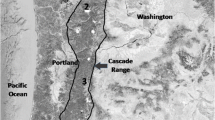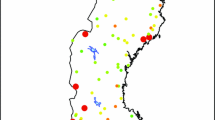Abstract
Changes in lake-water pH, alkalinity and colour were inferred from diatoms in surface sediment samples and sediment samples from pre-industrial times from 118 northern Swedish lakes. This palaeolimnological study does not support the hypothesis that there is a large-scale modern acidification in the two northernmost counties of Sweden; pH had decreased significantly in eight lakes, while five had a significant increase. Partial least-squares regression of changes in water chemistry in relation to catchment characteristics was performed to evaluate the causes of the acidity status. Furthermore, temporal trends were assessed from long sediment cores from five acidic lakes. The results suggest that the presently acid lakes have faced a long-term acidification trend over several thousand years due to soil-forming processes and vegetation development. However, due to the acid sensitivity of the region, future acidification trends in northern Swedish lakes should be carefully observed and assessed.
Similar content being viewed by others
References
Anderson, N. J., 1993. Natural versus anthropogenic change in lakes: the role of the sediment record. Trends Ecol. Evol. 8: 356–361.
Anderson, N. J., I. Renberg & U. Segerström, 1995. Diatom production responses to the development of early agriculture in a boreal forest lake-catchment (Kassjön, Northern Sweden). J. Ecol. 83: 809–822.
Battarbee, R. W., J. Mason, I. Renberg & J. F. Talling (eds), 1990. Palaeolimnology and lake acidification. The Royal Society, London, 219 pp.
Battarbee, R. W., D. F. Charles, S. S. Dixit & I. Renberg, 1999. Diatoms as indicators of surface water acidity. In Stoermer E. F. & J.P. Smol (eds), The diatoms: applications for the environmental and earth sciences. Cambridge University Press, Cambridge: 85–127.
Bernes, C., 1991. Acidification and liming of Swedish freshwaters. Monitor 12. Swedish Environmental Protection Agency, Solna, 144 pp.
Bernes, C. & E. Thörnelöf, 1990. Present and future acidification of Swedish lakes: model calculations based on an extensive survey. In Kämäri J. (ed), Impact models to assess regional acidification. Kluwer Academic Publishers, London: 83–107.
Birks, H. J. B., J. M. Line, S. Juggins, A. C. Stevenson & C. J. F. ter Braak, 1990. Diatoms and pH reconstruction. Phil. Trans. r. Soc. London B 327: 263–278.
Bishop, K. H., 1991. Is there more to acidity in organic-rich surface waters than air pollution? An example from Northern Sweden. Vatten 47: 342–347.
Bishop, K. H., 1997. Liming of acid surface waters in northern Sweden: questions of geographical variation and the precautionary principle. Trans. Inst. Br. Geogr. 22: 49–60.
Cumming, B. F., J. P. Smol, J. C. Kingston, D. F. Charles, H. J. B. Birks, K. E. Camburn, S. S. Dixit, A. J. Uutala & A. R. Selle, 1992. How much acidification has occurred in Adirondack region lakes (New York, USA) since preindustrial times? Can. J. Fish. aquat. Sci. 49: 128–141.
Cumming, B. F., K. A. Davey, J. P. Smol & H. J. B. Birks, 1994. When did acid-sensitive Adirondack lakes (New York, USA) begin to acidify and are they still acidifying? Can. J. Fish. aquat. Sci. 51: 1550–1568.
Digerfeldt, G., 1972. The post-glacial development of Lake Trummen. Folia Limn. Scand. 16: 1–96.
Dixit, S. S. & J. P. Smol, 1994. Diatoms as indicators in the Environmental Monitoring and Assessment Program-Surface Waters (EMAP-SW). Env. Monitor. Assessm. 31: 275–306.
Dixit, S. S., A. S. Dixit & J. P. Smol, 1992. Assessment of changes in lake water chemistry in Sudbury area lakes since preindustrial times. Can. J. Fish. aquat. Sci. 49(Suppl. 1): 8–16.
Engelmark, O., 1987. Fire history correlations to forest type and topography in northern Sweden. Ann. Bot. Fenn. 24: 317–324.
Hall, R. I. & J. P. Smol, 1996. Paleolimnological assessment of long-term water-quality changes in south-central Ontario lakes affected by cottage development and acidification. Can. J. Fish. aquat. Sci. 53: 1–17.
Henriksen, A., J. Kämäri, M. Posch & A. Wilander, 1992. Critical loads of acidity: Nordic surface waters. Ambio 21: 356–363.
Ivarsson, H. & M. Jansson, 1995. Sources of acidity in running waters in central northern Sweden. Water Air Soil Pollut. 84: 233–251.
Johansson, K., 1989. Metals in sediment of lakes in northern Sweden. Water Air Soil Pollut. 47: 441–455.
Juggins, S. & C. J. F. ter Braak, 1993. CALIBRATE-a program for species-environment calibration by [weighted-averaging] partial least squares regression. Environmental Change Research Centre, University College, London.
Korhola, A., J. Virkanen, M. Tikkanen & T. Blom, 1996. Fireinduced pH rise in a naturally acid hill-top lake, southern Finland-a palaeoecological survey. J. Ecol. 84: 257–265.
Korsman, T. & H. J. B. Birks, 1996. Diatom-based water chemistry reconstructions: a comparison of reconstruction techniques. J. Paleolim. 15: 65–77.
Korsman, T. & U. Segerström, 1998. Forest fire and lake-water acidity in a northern Swedish boreal area: Holocene changes in water quality at Makkassjön. J. Ecol. 86: 113–124.
Korsman, T., I. Renberg & N. J. Anderson, 1994. A palaeolimnological test of the influence of Norway spruce (Picea abies) immigration on lake-water acidity. Holocene 4: 132–140.
Kullberg, A., K. H. Bishop, A. Hargeby, M. Jansson & R. C. Petersen, Jr., 1993. The ecological significance of dissolved organic carbon in acidified waters. Ambio 22: 331–337.
Line, J. M., C. J. F. ter Braak & H. J. B. Birks, 1994. WACALIB version 3.3-a computer program to reconstruct environmental variables from fossil assemblages by weighted averaging and to derive sample-specific errors of prediction. J. Paleolim. 10: 147–152.
Lundqvist, M. (ed), 1953. Atlasöver Sverige. Svenska Sällskapet för Antropologi och Geografi. Stockholm. (In Swedish).
Martens, H. & T. Næ s, 1989. Multivariate calibration. John Wiley & Sons, New York, 419 pp.
Petterson, G., I. Renberg, P. Geladi, A. Lindberg & F. Lindgren, 1993. Spatial uniformity of sediment accumulation in varved lake sediments in northern Sweden. J. Paleolim. 9: 195–208.
Prentice, I. C., 1980. Multidimensional scaling as a research tool in Quaternary palynology: a review of theory and methods. Rev. Palaeobot. Palynol. 31: 71–104.
Rasmussen, J. B., L. Godbout & M. Schallenberg, 1989. The humic content of lake water and its relationships to watershed and lake morphometry. Limnol. Oceanogr. 34: 1336–1343.
Renberg, I., 1976. Palaeolimnological investigations in Lake Prästsjön. Early Norrland 9: 113–159.
Renberg, I., 1986. A sedimentary record of severe acidification in Lake Blå missusjön, N. Sweden, through natural soil processes. In Smol J. P., R. W. Battarbee, R. B. Davis & J. Meriläinen (eds), Diatoms and lake acidity. Dr W. Junk Publishers, Dordrecht: 213–219.
Renberg, I., 1990a. A procedure for preparing large sets of diatom slides from sediment cores. J. Paleolim. 4: 87–90.
Renberg, I., 1990b. A 12000 year perspective of the acidification of Lilla Öresjön, southwest Sweden. Phil. Trans. r. Soc. London B 327: 357–361.
Renberg, I., 1991. The HON-Kajak sediment corer. J. Paleolim. 6: 167–170.
Renberg, I., Y. W. Brodin, G. Cronberg, F. El-Daoushy, F. Oldfield, B. Rippey, S. Sandø y, J. E. Wallin & M. Wik, 1990. Recent acidification and biological changes in Lilla Öresjön, south-west Sweden, and the relation to atmospheric pollution and land-use history. Phil. Trans. r. Soc. London B 327: 391–396.
Renberg, I., T. Korsman & N. J. Anderson, 1993a. A temporal perspective of lake acidification in Sweden. Ambio 22: 264–271.
Renberg, I., T. Korsman & H. J. B. Birks, 1993b. Prehistoric increases in the pH of acid-sensitive Swedish lakes caused by land-use changes. Nature 362: 824–827.
Rhodes, T. E. & R. B. Davis, 1995. Effects of late Holocene forest disturbance and vegetation change on acidic Mud Pond, Maine, USA. Ecology 76: 734–746.
Rochelle, B. P., C. I. Liff, W. G. Campbell, D. L. Cassell, M. R. Church & R. A. Nusz, 1989. Regional relationships between geomorphic/hydrological parameters and surface water chemistry relative to acidic deposition. J. Hydrol. 112: 103–120.
Schindler, D. W., S. E. Bayley, P. J. Curtis, B. R. Parker, M. P. Stainton & C. A. Kelly, 1992. Natural and man-caused factors affecting the abundance and cycling of dissolved organic substances in precambrian shield lakes. Hydrobiologia 229: 1–21.
Segerström, U., 1990. The natural Holocene vegetation development and the introduction of agriculture in northern Norrland, Sweden. Studies of soil, peat and especially varved lake sediments. Doctoral thesis, Umeå University, Sweden.
Smol, J. P., 1992. Paleolimnology: an important tool for effective ecosystem management. J. aquat. Ecosyst. Health 1: 49–58.
Sullivan, T. J. (ed), 1990. Historical changes in surface water acidbase chemistry in response to acidic deposition. Report 11. NAPAP State of Science and Technology. National Acid Pecipitation Assessment Program, Washington, D.C., 181 pp.
Sullivan, T. J., B. J. Cosby, C. T. Driscoll, D. F. Charles & H. F. Hemond, 1996. Influence of organic acids on model projections of lake acidification. Water Air Soil Pollut. 91: 271–282.
Sverdrup, H., P. Warfvinge, T. Frogner, A. O. Hå ø ya, M. Johansson & B. Andersen, 1992. Critical loads for forest soils in the Nordic countries. Ambio 21: 348–355.
Tallantire, P. A., 1972. The regional spread of spruce (Picea abies (L.) Karst.) within Fennoscandia: a reassessment. Norw. J. Bot. 19: 1–16.
Tallantire, P. A., 1977. A further contribution to the problem of the spread of spruce (Picea abies (L.) Karst.) in Fennoscandia. J. Biogeogr. 4: 219–227.
Ter Braak, C. J. F., 1988. CANOCO-A FORTRAN program for canonical community ordination by [partial] [detrended] [canonical] correspondence analysis, principal components analysis and redundancy analysis (version 2.1). Technical Report LWA–88–02, GLW, Wageningen, 90 pp.
Ter Braak, C. J. F., 1990. Update notes: CANOCO VERSION 3.10. Agricultural Mathematics Group, Wageningen, 35 pp.
Warfvinge, P., S. Löfgren & U. Lundström, 1995. Implications of natural acidification for mitigation strategies in northern Sweden. Water Air Soil Pollut. 85: 499–504.
Wik, M., 1992. Environmental records of carbonaceous fly-ash particles from fossil fuel combustion. Doctoral thesis, Umeå University, Sweden.
Zachrisson, O., 1976. Vegetation dynamics and land use in the lower reaches of the river Umeälven. Early Norrland 9: 7–74.
Zachrisson, O., 1977. Influence of forest fires on the North Swedish boreal forest. Oikos 29: 22–32.
Author information
Authors and Affiliations
Rights and permissions
About this article
Cite this article
Korsman, T. Temporal and spatial trends of lake acidity in northern Sweden. Journal of Paleolimnology 22, 1–15 (1999). https://doi.org/10.1023/A:1008003218065
Issue Date:
DOI: https://doi.org/10.1023/A:1008003218065




